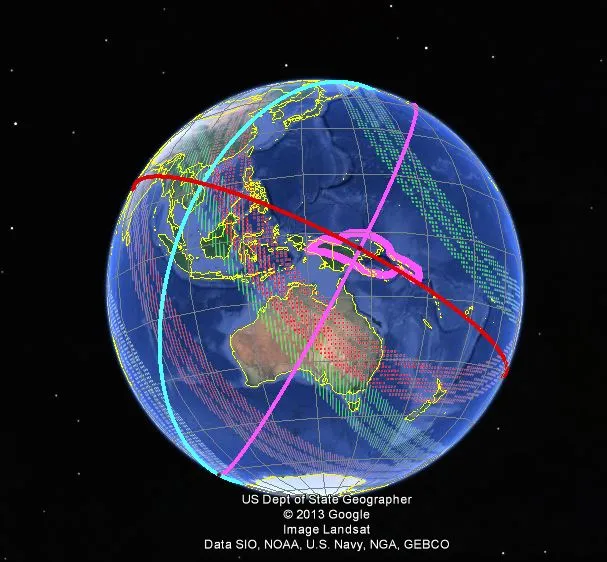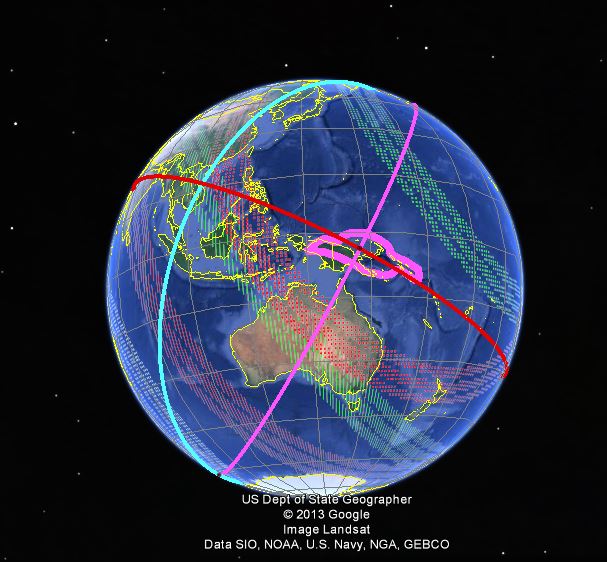
Explanation for the Output of the Iasoberg Model
Instead of a Legend for the interpretation of the displays of the output of the Iasoberg Model, a detailed description of the elements of the model will provide the observer with a more comprehensive understanding of what the elements represent.
It would be very useful for the reader to take the time to view The Allias Effect – The Iasoberg Model – The Future presentation and read the paper on the Papua New Guinea and Western South American Terrestrial Gravitational Anomaly Plane to gain a reasonable understanding of the Allais Effect and the Iasoberg Model. The links to these two documents are below:
https://www.facebook.com/download/414664981993270/PNGWSATGAPlaneandAllaisEffectFinaldoc.pdf
There are 4 Iasoberg Model spatial configurations that are generated by various algorithms (programs) and displayed on most graphs and charts. The iasobergs (3 band 3xred and 3xgreen bands) and the celestial subpoints (sun – red, blue – moon and green – center of the galaxy) are essentially fixed as the Earth rotates through them in a 24 hour period. The other 2 configurations, ie the PNGWSATGA Plane and the boundaries of the tectonic plates obviously rotate with the Earth.
So let’s start with the iasobergs. The term iasoberg, was a term coined as the generic descriptor of the regions where the Iasoberg Model output intersect the Earth’s surface to indicate the influence of the Allais Effect. Initially, an iasoberg was displayed as a line on the Earth’s surface to indicate its location. This early model consisted of 4 iasobergs (lines), two associated with the Sun and 2 with the two with center of the galaxy. The solar iasobergs were focused at the barycenter of the Earth Moon system and the anti-barycenter, which is a point on the Earth Moon axis opposite to the barycenter and at the same distance from the center of the Earth to the barycenter. The galactic iasobergs were configured similarly to the solar iasobergs.
Prior to a study of severe wind events in August 2008, 2 additional iasobergs had been developed to provide additional intersections on the Earth’s surface for investigating links between event(s) and the output of the model. These two additional iasobergs were styled the Solar and Galactic Earth Centric Iasobergs focused at the mass center of the Earth. The geometry of these Iasobergs was as per the initial 4. The lines were further developed into 3 bands for each iasoberg. The 3 band iasoberg was developed as an exploratory representation of the observations recorded in the Saxl and Allen experiment (1970) and the 3 clusters of severe events described in the severe wind study. All the work and results presented in Note 4, a study on severe wind events in August 2008 in continental USA, were based on the current versions of the model and its associated software, the Iasoberg Model algorithms. The current set of 6 iasobergs are configured with 3 bands (3 iasobergs are linked to the Sun and are displayed with red dots and lines, and 3 linked to the center of the galaxy – similarly displayed in green).
The 3 solar linked iasobergs are shown with red dots and vertical lines on various maps and charts. The 3 bands of dark red dots indicate the iasoberg focused at the Earth Moon System barycenter styled the Solar Fundamental Iasoberg. The 3 bands of vertical lines indicate the iasoberg focused at the center of the Earth styled the Earth Centric Solar Iasoberg. And the 3 bands of light red dots indicate the iasoberg focused at the anti barycenter styled the Solar Mirror Image Iasoberg. The galactic/green iasobergs are configured and styled similarly as the solar iasobergs, except they are linked to the center of the galaxy.
Next, we have 3 points which are included in all displays; they are the subpoints of the Sun (red), Moon (blue) and center of the galaxy (green). The subpoint is where the axis between the above celestial body and the center of the Earth intersects the surface of the Earth. We have found in some of our work that their location in conjunction with the iasobergs have correlated with observations/reports of various geophysical events.
Thirdly, we have the elements associated with PNGWSATGA Plane (great circle shown as a red line) and iasospots (Iasospot 1 – PNG Magenta polygon – Iasospot 2 – WSA cyan polygon) which are shown in all maps/charts. The polygons represent two regions of the earth where there are significant terrestrial gravitational anomalies. Two additional elements have been included to the PNGWSATGA Plane configuration as a result of severe weather event observations. They are planes that are orthogonal to the PNGWSATGA plane and intersect the PNGWSATGA plane at the centroids of the PNG and WSA polygons.
Finally, in some maps you will also see lines of yellow dots which represent the boundaries of Earth’s tectonic plates.
At this stage there is no rationale for the distortion of the solar and galactic gravitational fields focused at the barycenter and anti barycenter of the Earth Moon system and mass center of the Earth. However, if the above fields are distorted, as hypothesized , that is one way field theory can accommodate non homogeneous gravitational vectors on the Earth’s surface that emanate from the above points within the Earth. iasoberg.com have a series of algorithms (programs) developed by my brother and myself, which can generate the locations for these ‘hypothesized’ distortions very accurately for any instant of time between 2500BC to 2500AD.
All the features presented on maps reflecting the output of the Iasoberg Model are subject to the dynamics of gravity. The iasobergs (hypothetical distorted gravitational potentials), the subpoints and regions near them (m1 x m2/r2), the TGAs because of more mass in those regions of the Earth and the tectonic plates which indicate the boundaries of large masses near the Earth’s surface are dynamically linked. It is my contention that these elements contribute to the dynamics that influence our terrestrial environment. It is important to note that some of these elements are constantly moving relative to each other, in some instances in excess of 1600 km/hr!!!!
Related Articles on Iasoberg Model
Did you like this article? Read more and subscribe to our monthly newsletter!





